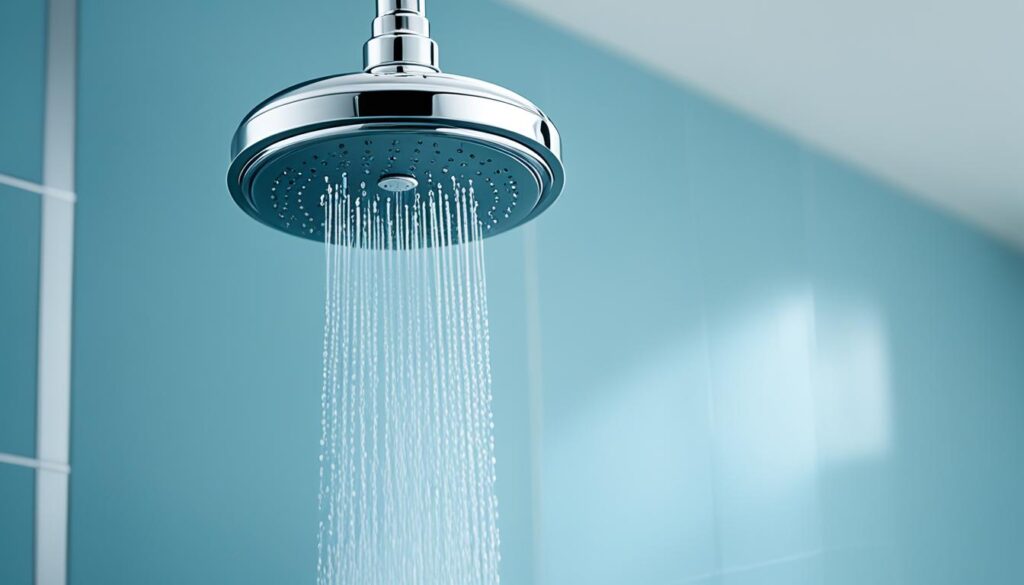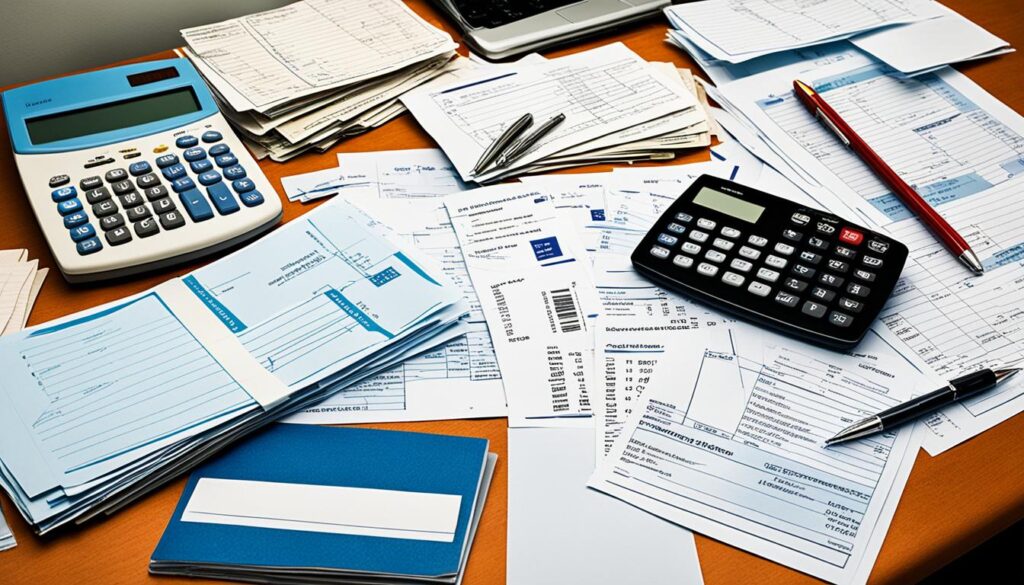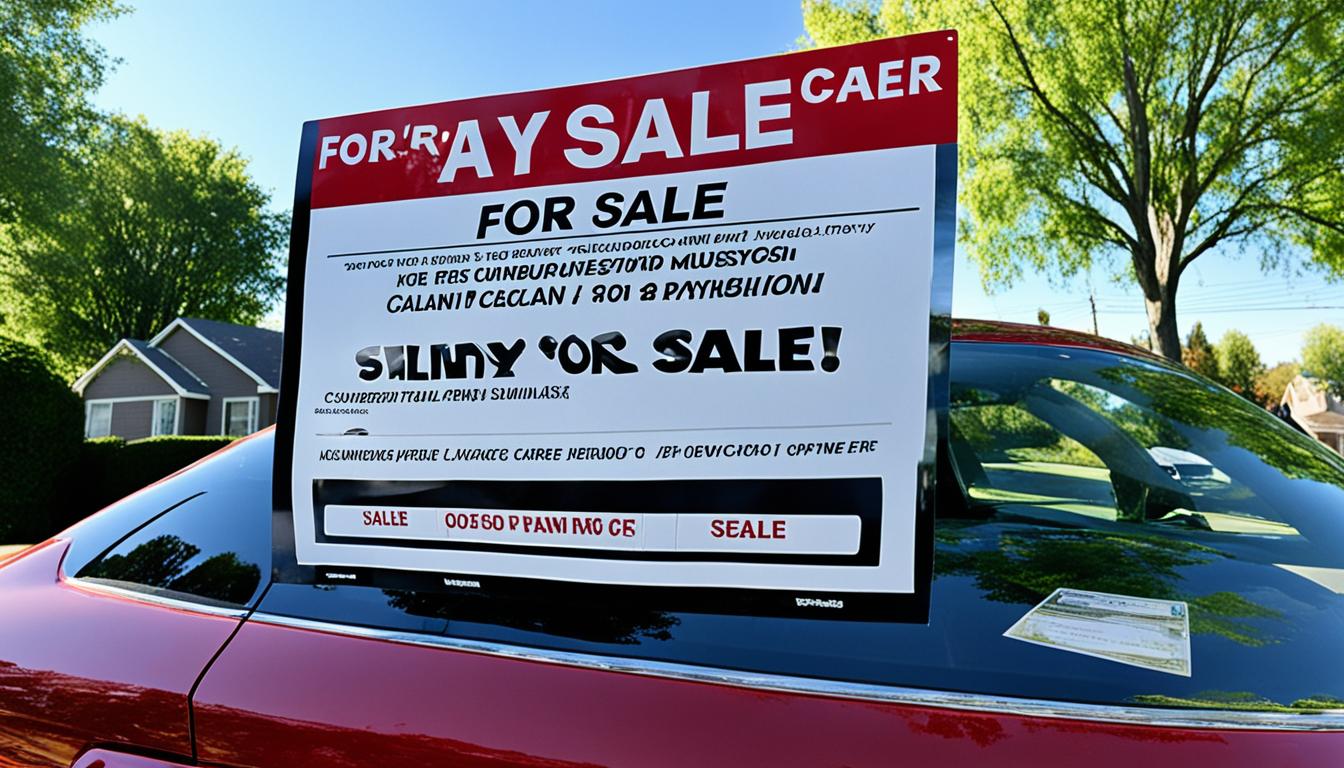Managing finances can be challenging for many individuals in the United States, leading to struggles in keeping up with bills. According to recent statistics, a significant portion of the population faces mounting financial burdens. Luckily, there are various techniques to help reduce payments and regain financial stability. By incorporating these strategies, you can decrease monthly obligations and alleviate financial stress. Discover valuable insights and actionable steps to trim expenses and minimize payment responsibilities. Dive into the world of financial management and start the journey toward financial freedom.
Key Takeaways:
- Discover effective strategies to reduce your payments and take control of your finances.
- Learn how to shop secondhand and sell your clothes to save money on clothing expenses.
- Find out how to lower your mortgage payments through refinancing and biweekly payments.
- Explore ways to negotiate your rent and reduce your monthly rental payments.
- Get tips on cutting down on your grocery bills and minimizing home-supplies shopping costs.
Shop Secondhand and Sell Your Clothes
One effective way to reduce payments is by shopping secondhand. Thrift stores and consignment shops offer affordable clothing options, and some even have special discount days or bulk purchase discounts. Additionally, individuals can sell their gently used clothing at brick-and-mortar secondhand stores or through online platforms like thredUP. Participating in clothing swaps or joining buy/sell groups on social media can also help individuals find free or low-cost clothing options.
Buying secondhand not only saves money but also contributes to sustainability by reducing waste and supporting local communities. It’s a win-win situation! When you shop secondhand, you can find unique and stylish clothing items at a fraction of the original price. Plus, you’ll always be ahead of the fashion curve, as thrift stores often carry vintage and trendy pieces.
| Benefits of Shopping Secondhand and Selling Your Clothes | How to Get Started |
|---|---|
|
|
When selling your clothes, make sure to inspect each item thoroughly, as quality plays a significant role in attracting buyers. Take clear and well-lit photos to showcase the items’ features and descriptions accurately. Highlight any unique or high-value pieces to increase their chances of selling. Remember, one person’s pre-loved clothing can be another person’s treasure!
“Buying secondhand not only saves money but also contributes to sustainability by reducing waste and supporting local communities. It’s a win-win situation!”
Not only can you shop secondhand, but you can also participate in clothing swaps or join buy/sell groups on social media. Clothing swaps provide an opportunity to trade items with others, giving you the chance to refresh your wardrobe without spending any money. Joining buy/sell groups on social media platforms like Facebook or dedicated apps allows you to connect with local sellers and buyers, making it convenient and easy to find affordable clothing.
Remember, reducing payments doesn’t mean compromising on style or quality. Shopping secondhand can help you save money, support sustainable fashion, and find unique pieces that reflect your personal style. So why not give it a try and embark on a thrifty shopping adventure?
Lower Your Mortgage Payments
If you’re a homeowner looking to reduce your mortgage payments, there are strategies you can implement to achieve this goal. Two effective methods are refinancing your mortgage and making biweekly payments.
Refinance Your Mortgage
Refinancing your mortgage can be a smart move, especially when interest rates are low. By refinancing, you can potentially secure a lower interest rate on your loan, resulting in significant savings over the lifetime of the mortgage. This can lead to lower monthly mortgage payments and a reduced financial burden.
When considering refinancing, it’s essential to take into account the closing costs associated with the process. While there may be upfront fees, the long-term savings can outweigh these initial expenses. Consulting with a mortgage professional can provide insights into the potential cost savings and help you make an informed decision.
Make Biweekly Mortgage Payments
An alternative approach to lowering your mortgage payments is to switch from monthly payments to biweekly payments. Instead of paying your mortgage once a month, you’ll make a payment every two weeks. This leads to 26 half-payments in a year, equivalent to 13 full payments.
The benefit of biweekly payments is that you’re effectively making an extra payment each year, which goes directly towards your principal balance. By accelerating the repayment of the principal, you can reduce the overall amount of interest paid over the life of the loan and shorten the loan term.
Making biweekly payments requires careful planning and budgeting. Before pursuing this approach, it’s crucial to contact your mortgage lender and ensure they offer this payment option. They can provide specific instructions on how to set up the biweekly payment schedule and adjust your budget accordingly.

Lowering your mortgage payments is a strategic move that can ease your financial burden and improve your overall cash flow. Whether you choose to refinance your mortgage or make biweekly payments, exploring these options can open up opportunities for significant savings.
Negotiate Your Rent
As a renter, there are effective ways to lower your monthly rental payments. One strategy is to negotiate with your landlord, especially if you have built a good relationship and demonstrated timely payment history. By opening up a conversation about your rent, you may be able to reach a mutually beneficial agreement that reduces your monthly expenses.
Additionally, choosing the right timing can play a significant role in negotiating your rent. Signing a lease in the fall or winter, when there is typically less demand for rental properties, can give you an advantage when it comes to negotiating rental prices. With a lower demand, landlords may be more willing to lower their rental rates, allowing you to secure a more affordable living arrangement.
To negotiate your rent effectively, consider the following tips:
- Research rental prices in your area to understand the current market rates and gain leverage in your negotiation.
- Prepare a solid case by highlighting your positive rental history, responsible financial habits, and any improvements or repairs you have made to the property.
- Approach the negotiation in a respectful and professional manner, emphasizing the benefits of a long-term, reliable tenant.
- Be open to compromise and explore potential solutions that work for both parties, such as signing a longer lease or taking on some maintenance responsibilities.
Expert Tip
“Remember, negotiating your rent is a two-way conversation. Approach the discussion with a positive attitude and a win-win mindset. Focus on finding a solution that benefits both you and your landlord.”
– Jane Smith, Real Estate Consultant
Negotiating your rent can lead to significant savings and help you achieve your financial goals. Whether it’s by building a good relationship with your landlord, taking advantage of low-demand seasons, or exploring compromise, these strategies can empower you to lower your monthly rental payments and create more room in your budget for other expenses.

Cut Down on Grocery Bills
When it comes to reducing expenses, one area where you can make a significant impact is your grocery bills. By making a few smart choices and utilizing technology, you can save money on your weekly shopping trips. Here are some strategies that can help you cut down on your grocery expenses:
Shop Online for Convenience and Savings
Shopping online can be a great way to avoid impulsive purchases and save money. With just a few clicks, you can fill your virtual cart with the items you need, without the distractions of store displays or sales tactics. Shopping online also allows you to easily compare prices and find the best deals, ensuring that you get the most value for your money.

Take Advantage of Re-Stock Days
Planning your shopping trips on re-stock days can be a smart move. On these days, stores often offer discounts or special promotions to clear out their inventory and make room for new products. By timing your purchases accordingly, you can take advantage of these discounts and enjoy significant savings on your groceries.
Use Cash-Back Grocery Apps
Cash-back grocery apps like Ibotta can be a game-changer when it comes to saving money on groceries. These apps allow you to earn cash back on the items you already purchase. Simply scan your receipts, and the app will automatically credit your account with cash back. It’s an effortless way to put some extra money back in your pocket.
Make the Most of Rain Checks and Seasonal Produce
Rain checks are a valuable tool for saving money on items that are temporarily out of stock. If a product you want is on sale but unavailable, ask for a rain check, and you can purchase it at the discounted price when it’s back in stock. Additionally, buying produce seasonally can help you save money, as fruits and vegetables are typically cheaper when they are in season.
By implementing these strategies, you can significantly cut down on your grocery bills and keep more money in your pocket. Remember, a little planning and smart shopping can go a long way in helping you save.
Minimize Home-Supplies Shopping Costs
When it comes to shopping for home supplies, there are several ways to cut down on costs and save money. By making a few simple changes to your buying habits and daily routines, you can make a significant impact on your budget. Here are some strategies to help you minimize home-supplies shopping costs:
1. Buy Generic Products
Instead of purchasing expensive name brand items, opt for generic products. Many generic items offer the same quality and effectiveness as their branded counterparts but at a lower price. By choosing generic options, you can save money without sacrificing the functionality or quality of the products you need.
2. Reduce Single-Use Items
Single-use items like plastic baggies and paper towels can add up to a significant expense over time. Minimize your use of these disposable products and consider reusable alternatives. Invest in reusable food storage containers and cloth towels instead of disposable options. Not only will this help reduce your expenses, but it will also contribute to a more sustainable lifestyle.
3. Make Homemade Cleaning Products
Instead of buying expensive cleaning products, consider making your own at home. Homemade cleaning solutions are not only cost-effective but also better for the environment. Basic ingredients like vinegar, baking soda, and lemon juice can be used to create effective cleaning agents for various purposes. Making your own cleaning products allows you to save money while customizing the ingredients to suit your specific cleaning needs.

By implementing these strategies, you can significantly reduce your home-supplies shopping costs. Buying generic products, reducing single-use items, and making homemade cleaning products are all practical and sustainable ways to save money while maintaining a well-stocked and clean home.
Lower Water Consumption
Reducing water consumption is not only good for the environment but can also lead to significant savings on your water bills. By adopting a few simple habits and making some minor changes in your daily routine, you can effectively lower your water usage and cut down on your expenses.
Use Aerators and Low-Flow Showerheads
Installing aerators and low-flow showerheads is an easy and cost-effective way to minimize water usage without sacrificing your shower experience. These devices work by adding air to the water flow, maintaining good water pressure while reducing the amount of water consumed. By using aerators on faucets and low-flow showerheads in your bathroom, you can save a significant amount of water each day.
To help put things into perspective, here’s a comparison between water consumption with and without aerators and low-flow showerheads:
| Water Consumption Without Devices | Water Consumption With Devices | |
|---|---|---|
| Showers | 8 gallons per minute | 2 gallons per minute |
| Faucets | 2 gallons per minute | 0.5 gallons per minute |
As you can see, using aerators and low-flow showerheads can help you save up to 75% of water during showers and reduce faucet water usage by half.
Take Faster Showers
Another effective way to reduce water consumption is by taking shorter showers. While long, relaxing showers may be enjoyable, they also contribute significantly to higher water bills. By making a conscious effort to take faster showers, you can save a considerable amount of water and reduce your expenses.
Here are some tips to help you take faster showers:
- Set a timer to keep track of the time spent in the shower.
- Use a waterproof Bluetooth speaker to play your favorite songs and keep you on track.
- Opt for efficient shower routines, such as wetting your body, turning off the shower while you lather up, and then rinsing off quickly.
Taking faster showers not only reduces water consumption but also saves time, allowing you to be more efficient in your daily routine.

Avoid Using the Toilet as a Wastebasket
Using the toilet to dispose of small bits of trash may seem convenient, but it wastes several gallons of water with each flush. To conserve water, it’s best to use a wastebasket for disposing of non-flushable items such as tissues, dental floss, and cotton swabs.
“Conserving water is not only environmentally responsible, but it also translates to significant savings on your water bills. By using aerators and low-flow showerheads, taking faster showers, and avoiding using the toilet as a wastebasket, you can make a positive impact on both the planet and your wallet.”
Reduce Air-Conditioning and Heating Costs
When it comes to reducing air-conditioning and heating costs, a few simple strategies can make a significant difference. By implementing these strategies, you can not only save energy but also decrease your utility bills.
Use Ceiling Fans
One effective way to reduce air-conditioning costs is by utilizing ceiling fans. Ceiling fans help circulate the air in the room, creating a cooling effect and making you feel more comfortable. By using ceiling fans in conjunction with your AC, you can raise the temperature on your thermostat without sacrificing comfort. This can lead to energy savings and lower utility bills.
Invest in Heavy Curtains
Another strategy to reduce heating and cooling costs is by investing in heavy curtains. Heavy curtains can help regulate the temperature in your home by preventing sunlight from entering during hot summer days and insulating against cold drafts during winter. By keeping the heat out in the summer and retaining warmth in the winter, you can reduce your reliance on air-conditioning and heating systems, resulting in energy savings.

Implementing these strategies not only helps you save money but also contributes to a more sustainable lifestyle. By using ceiling fans to circulate air and investing in heavy curtains to regulate room temperature, you can create a more energy-efficient and comfortable living environment.
Create a Comprehensive List of Bills
When it comes to effective bill tracking, creating a comprehensive list of bills is essential. This list should include all the various bills you need to pay, whether they are monthly, quarterly, semi-annually, or annual expenses. By including all your bills in one place, you can easily keep track of your financial obligations and avoid missing any payments.
Here’s a breakdown of the important details to include in your bill list:
- Bill Name: Clearly identify each bill by name. This could be the name of the service provider or the type of expense (e.g., rent, utilities, credit card).
- Bill Details: Provide additional information about each bill, such as the account number, contract details, or any specific requirements.
- Due Date: Include the due date for each bill to ensure you know when payments are expected.
- Bill Frequency: Indicate whether the bill is a monthly, quarterly, semi-annual, or annual expense.
Organizing your list by due date can help you prioritize payments and plan your budget accordingly. By having a complete and well-structured list of your bills, you’ll have better control over your finances and avoid any late fees or penalties.
Take a look at the example table below to see how you can structure your bill list:

| Bill Name | Bill Details | Due Date | Bill Frequency |
|---|---|---|---|
| Rent | Apartment 123 | 1st of every month | Monthly |
| Electricity | Account number: 987654321 | 15th of every month | Monthly |
| Internet | Service provider: XYZ Internet | 10th of every month | Monthly |
| Car Insurance | Policy number: 123456789 | 6th of January, April, July, October | Quarterly |
| Annual Membership | Expires on April 30th | 30th of April | Annual |
Integrate Bills Into Your Calendar
Keeping track of your bills and payment deadlines is essential for effective financial management. By integrating your bills into a calendar system, you can stay organized and ensure that you never miss a payment. Follow these steps to seamlessly integrate your bills into your calendar:
Create a Separate Calendar for Bills and Expenses
To avoid clutter and efficiently manage your bill payments, create a separate calendar dedicated to your bills and expenses. This way, you can easily distinguish your financial obligations from other events or appointments.
Add Bill Details to Your Calendar
When adding your bills to the calendar, make sure to include important details such as the amount due, due date, and the name of the biller. This will provide you with a comprehensive overview of your upcoming payment obligations and help you plan your budget accordingly.
Set Calendar Reminders
Take advantage of calendar reminders to ensure that you never forget a bill payment. Set reminders a few days before the due date to give yourself enough time to prepare. Additionally, you can set recurring reminders for bills with regular due dates to streamline the process further.
Utilize Notifications
Calendar apps often offer notification features that can send you reminders directly to your phone or email. Utilize these notifications to stay informed about upcoming bill payments and avoid any late fees or penalties.
By integrating your bills into your calendar, you can effectively organize your payment schedule and stay on top of your financial commitments. Ensure that you review your calendar regularly and update it with any changes or new bills that may arise. With a well-structured calendar system in place, you can confidently manage your bills and maintain financial stability.

Set Payment Reminders
In addition to adding bills to a calendar, setting payment reminders is essential to avoid late payments. Forgetting bill due dates can lead to unnecessary fees and penalties that can put a strain on your budget. Fortunately, there are several effective methods to help you stay on top of your payments and ensure they are made on time.
Calendar Apps
Calendar apps are a convenient and efficient way to set up bill payment reminders. Simply input your bill due dates into your preferred calendar app, and you’ll receive notifications to remind you of upcoming payments. Some popular calendar apps include Google Calendar, Apple Calendar, and Microsoft Outlook.
Bill Payment Apps
If you prefer a dedicated bill management solution, consider using a bill payment app. These apps allow you to input your bills along with their due dates and payment amounts, and they will send you notifications when payments are due. Examples of bill payment apps include Mint, Prism, and Bill Reminder.
Sticky Notes and Alarms
For those who prefer a more traditional approach, you can use sticky notes and alarms as visual and auditory reminders. Place sticky notes in visible areas, such as your computer monitor or refrigerator, to remind you of upcoming bill payments. Additionally, set alarms on your phone or clock to alert you when it’s time to make a payment.
By utilizing these payment reminder methods, you’ll have enough time to prepare for your bills and ensure they are paid on time. This proactive approach to bill management will help you avoid late fees and penalties, allowing you to maintain a healthy financial situation.

Remember, staying organized and being proactive with your bill payments is key to financial success. Let these payment reminders be your helpful companions on your journey to better bill management.
Enroll in Autopay Services
Managing bill payments can often be overwhelming, with due dates scattered throughout the month. That’s where autopay services come in to streamline the process and provide peace of mind. By enrolling in autopay, you can ensure that your bills are paid automatically and on time, without the hassle of remembering payment due dates.
Automatic bill payments are a secure and convenient method of settling your financial obligations. Once you set up autopay, the payment amount will be deducted from your designated account on the scheduled due date. This eliminates the risk of late payments and helps protect your credit score from any negative impact.
While autopay offers great benefits, it’s important to remain vigilant by regularly reviewing your statements. By carefully reviewing your bills, you can catch any discrepancies or unexpected charges that may have slipped through the cracks. This additional step allows you to stay informed about your expenses and ensures that you are in control of your finances.
“Enrolling in autopay services simplifies the bill payment process and eliminates the need to remember payment due dates.”
– John Smith, Financial Expert
Benefits of Autopay Services:
- Convenience: Autopay simplifies bill payment by automating the process, saving you time and effort.
- Timely Payments: Automatic deductions ensure that your bills are paid on time, reducing the risk of late fees.
- Credit Score Protection: By avoiding late payments, autopay helps maintain a positive credit score and financial reputation.
- Peace of Mind: With autopay, you can rest easy knowing that your bills are taken care of without the need for manual intervention.
Steps to Enroll in Autopay:
- Contact Your Billing Companies: Reach out to your service providers, such as utilities, credit card companies, and lenders, to inquire about their autopay options.
- Provide Necessary Information: Supply the required details, including your bank account information or credit card details, to set up automatic payments.
- Verify Autopay Setup: Confirm that your autopay enrollment is successful and that payments will be deducted as scheduled.
- Review Statements: Regularly review your statements to ensure accuracy and promptly address any issues or discrepancies that might arise.

Enrolling in autopay services is a reliable and convenient approach to managing your bills. By automating your payments, you can reduce the stress associated with remembering due dates and avoid late fees. However, it’s important to stay vigilant and review your statements to maintain control over your finances. Take advantage of autopay services today and enjoy the benefits of effortless bill payments!
Use Expense Tracker Sheets
Keeping track of your bills and payments is essential for effective budgeting and financial management. Expense tracker sheets offer a simple and organized way to monitor your expenses, identify spending patterns, and make informed decisions about your budget. Whether you prefer printable templates or digital spreadsheets, these sheets can help optimize your cash flow management and achieve your financial goals.
The Benefits of Expense Tracker Sheets
Expense tracker sheets provide a range of benefits that can enhance your budgeting efforts. Here are some key advantages:
- Easy Monitoring: With expense tracker sheets, you can easily record and track your expenses on a regular basis. This allows you to stay aware of where your money is going and identify any areas where you may need to cut back.
- Identifying Spending Habits: By consistently tracking your expenses, you can gain valuable insights into your spending habits. This knowledge can help you make more informed decisions and adjust your budget accordingly.
- Budgeting Made Simple: Expense tracker sheets serve as a valuable tool for creating and managing your budget. By categorizing your expenses and comparing them to your income, you can establish realistic spending limits and allocate funds effectively.
Choosing the Right Format
Expense tracker sheets come in various formats to suit different preferences and needs. Here are a few options to consider:
- Printable Templates: Printable expense tracker templates can be downloaded and filled in by hand. These templates are convenient for those who prefer a tangible record of their expenses and easy access to their budget.
- Digital Spreadsheets: Digital expense tracker spreadsheets, such as Excel or Google Sheets, offer the flexibility of customization and automatic calculations. They allow for easy data entry and analysis, saving you time and effort.
An Example Expense Tracker Sheet
| Date | Description | Amount |
|---|---|---|
| 1/1/2022 | Grocery shopping | $100 |
| 1/5/2022 | Gasoline | $50 |
| 1/10/2022 | Utility bill | $80 |
| 1/15/2022 | Dinner with friends | $40 |
This table represents a basic example of an expense tracker sheet. You can customize it to include additional columns for specific categories or types of expenses, such as transportation or entertainment. Regularly updating this sheet will provide you with a clear overview of your expenditures and empower you to make informed financial decisions.
Start using expense tracker sheets today to gain better control over your spending habits and achieve your budgeting goals. By consistently monitoring your expenses and optimizing your cash flow, you’ll be on the path to financial success.
![]()
Explore Budgeting or Money Management Apps
When it comes to managing your finances, budgeting apps and money management apps can be powerful tools to help you stay on top of your expenses and track your financial goals. These apps provide a comprehensive overview of your finances, allowing you to monitor your income, expenses, and savings all in one place. They offer a range of features, including:
- Expense tracking: Easily track your spending habits and identify areas where you can cut back to save money.
- Budget setting: Set personalized budgets for different categories, such as groceries, entertainment, and transportation, to ensure you stay within your means.
- Payment reminders: Receive notifications for upcoming bill payments, helping you avoid late fees and missed payments.
By utilizing these budgeting and money management apps, you can gain a clearer understanding of your financial situation and make more informed decisions about your money. One popular app in this category is Cushion.ai, which not only offers expense tracking and budgeting features but also syncs your bills to Google Calendar for convenient reminders.
Benefits of Budgeting and Money Management Apps
Budgeting and money management apps come with a range of benefits that can simplify your financial life and help you achieve your financial goals. Here are some advantages worth considering:
- Streamlined organization: With everything in one place, these apps eliminate the need for multiple spreadsheets or paper-based tracking systems.
- Improved expense tracking: By categorizing your expenses and providing visual representations of your spending, these apps give you a clear picture of where your money is going.
- Goal-oriented approach: Many apps allow you to set financial goals and track your progress, helping you stay motivated and focused on achieving those goals.
- Time-saving: By automating tasks such as bill payment reminders and expense categorization, these apps save you valuable time and reduce the risk of human error.
- Credit-building opportunities: Some apps, like Cushion.ai, offer credit-building features that help you improve your credit score and access better financial opportunities in the future.
Whether you’re just starting your budgeting journey or looking to improve your existing money management strategies, budgeting and money management apps can be invaluable tools. They provide the convenience, organization, and insights you need to take control of your finances. So why not give them a try and see how they can help you achieve your financial goals?
Comparison of Popular Budgeting and Money Management Apps
| App Name | Key Features | Price | Compatibility |
|---|---|---|---|
| Mint | – Expense tracking – Budgeting – Bill reminders |
Free | iOS, Android |
| YNAB (You Need a Budget) | – Detailed budgeting – Goal tracking – Debt payoff tools |
$84/year | iOS, Android |
| Cushion.ai | – Expense tracking – Bill payment reminders – Credit-building features |
Free with premium options | iOS, Android |
| PocketGuard | – Real-time spending tracking – Customizable budgeting – Savings goals |
Free with premium options | iOS, Android |
“Budgeting apps have revolutionized the way we manage our personal finances. With advanced features and user-friendly interfaces, these apps are designed to make budgeting and expense tracking accessible to everyone.” – Financial Expert
Schedule When to Keep Track of Bills and Payments
Scheduling specific times for bill tracking is crucial to ensure I stay organized and avoid missed payments. I have found that by establishing a routine and setting aside dedicated time for this task, I can effectively stay on top of my financial responsibilities. Whether it’s daily, weekly, or monthly check-ins, keeping an eye on my bills and payments helps me maintain control over my finances.
One helpful practice I’ve adopted is checking my bank or credit card statements immediately after making purchases. This allows me to catch any discrepancies or unauthorized charges early on and address them promptly.
On a daily basis, I spend a few minutes reviewing my expenses and updating my budget. This allows me to stay mindful of my spending habits and make any necessary adjustments to ensure I stay within my financial means.
Weekly check-ins provide me with a more comprehensive overview of my finances. During this time, I review all my bills, ensuring I haven’t missed any due dates and examining my spending patterns. This helps me identify areas where I can make improvements and optimize my budget.
Monthly check-ins are particularly important as they allow me to have a holistic view of my financial situation. I take this time to review my income, expenses, and savings. This monthly assessment helps me make informed decisions about my financial goals and track my progress toward them.
By incorporating these scheduled check-ins, I maintain a clear understanding of my available funds and financial situation. It empowers me to stay proactive in managing my bills and payments, ensuring everything is paid on time and in order.
| Timeframe | Activities |
|---|---|
| Daily |
|
| Weekly |
|
| Monthly |
|
Conclusion
Financial management and bill tracking are essential aspects of effectively reducing payments and gaining control over your finances. By implementing the tips and strategies highlighted in this article, you can take proactive steps towards minimizing your monthly expenses and achieving financial stability.
One of the key strategies discussed is shopping secondhand, which can provide affordable clothing options and help you save money on your bills. Additionally, negotiating your rent, lower mortgage payments, and cutting down on grocery bills are effective ways to reduce your payment obligations.
Utilizing technology tools such as bill payment apps and expense trackers can significantly assist in managing and tracking your bills. These tools help you stay organized, set payment reminders, and keep a close eye on your expenses. By integrating bills into your calendar and creating a comprehensive list of bills, you can stay on top of your financial responsibilities and avoid late payments.
In conclusion, by practicing proactive financial management and implementing strategic bill tracking techniques, you can slash your bills and gain control over your finances. Take the first step today towards reducing your payment obligations and achieving financial stability. With dedication and consistent effort, you can take control of your financial situation and build a secure future.
FAQ
How can I reduce my payments?
What are some tips for shopping secondhand?
How can I lower my mortgage payments?
What can I do to negotiate my rent?
How can I cut down on my grocery bills?
How can I minimize home-supplies shopping costs?
What are some strategies to lower water consumption?
How can I reduce my air-conditioning and heating costs?
How can I create a comprehensive list of bills?
How can I integrate bills into my calendar?
What are some ways to set payment reminders?
How does enrolling in autopay services simplify bill payment?
How can I use expense tracker sheets to manage my bills and payments?
What are some popular budgeting or money management apps to explore?
How often should I schedule bill tracking?
Are Wells Fargo Payments Included in the Tips for Reducing Bills Effortlessly?
When looking for ways to reduce bills effortlessly, consider making discreet Wells Fargo payments towards outstanding balances. By making regular, timely payments, you can chip away at those bills and bring them down over time. This simple strategy can help you take control of your finances and reduce unnecessary stress.









